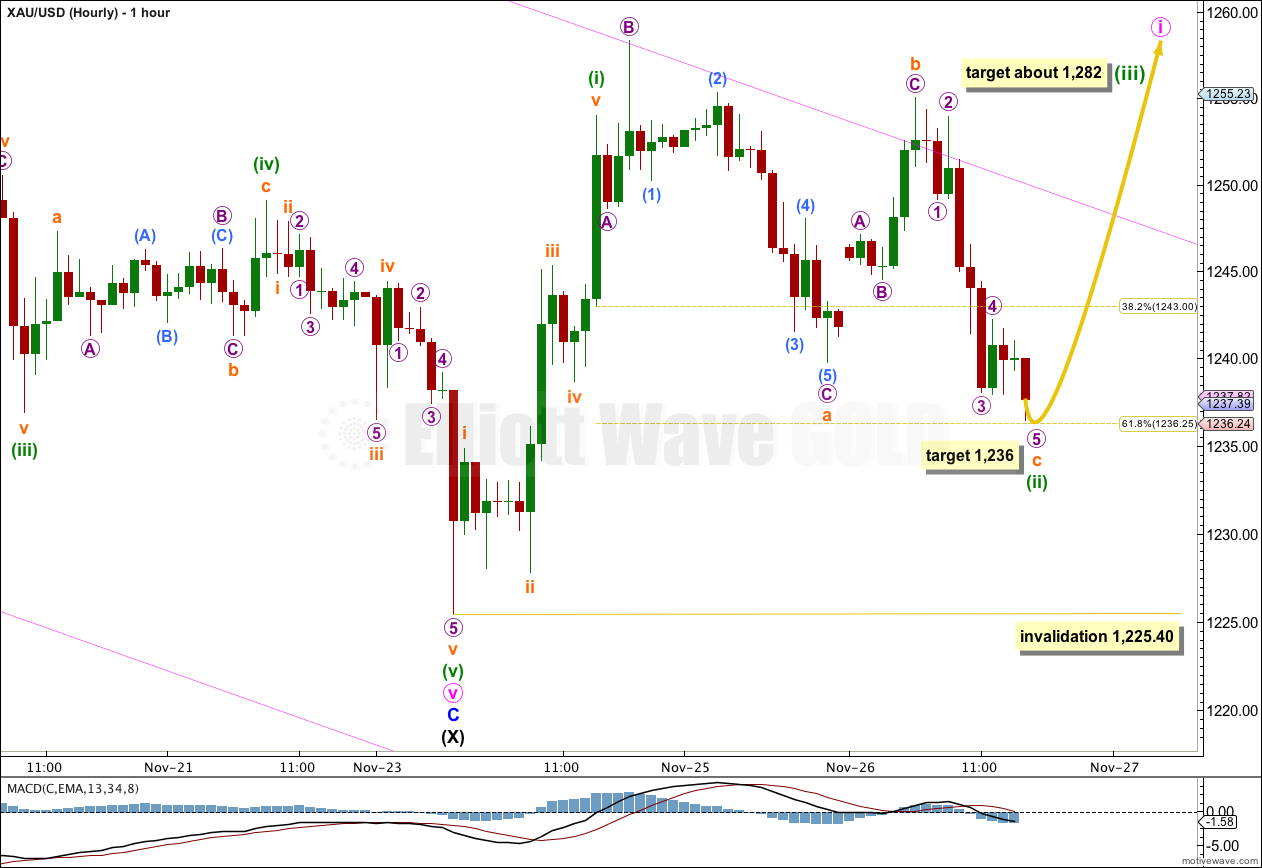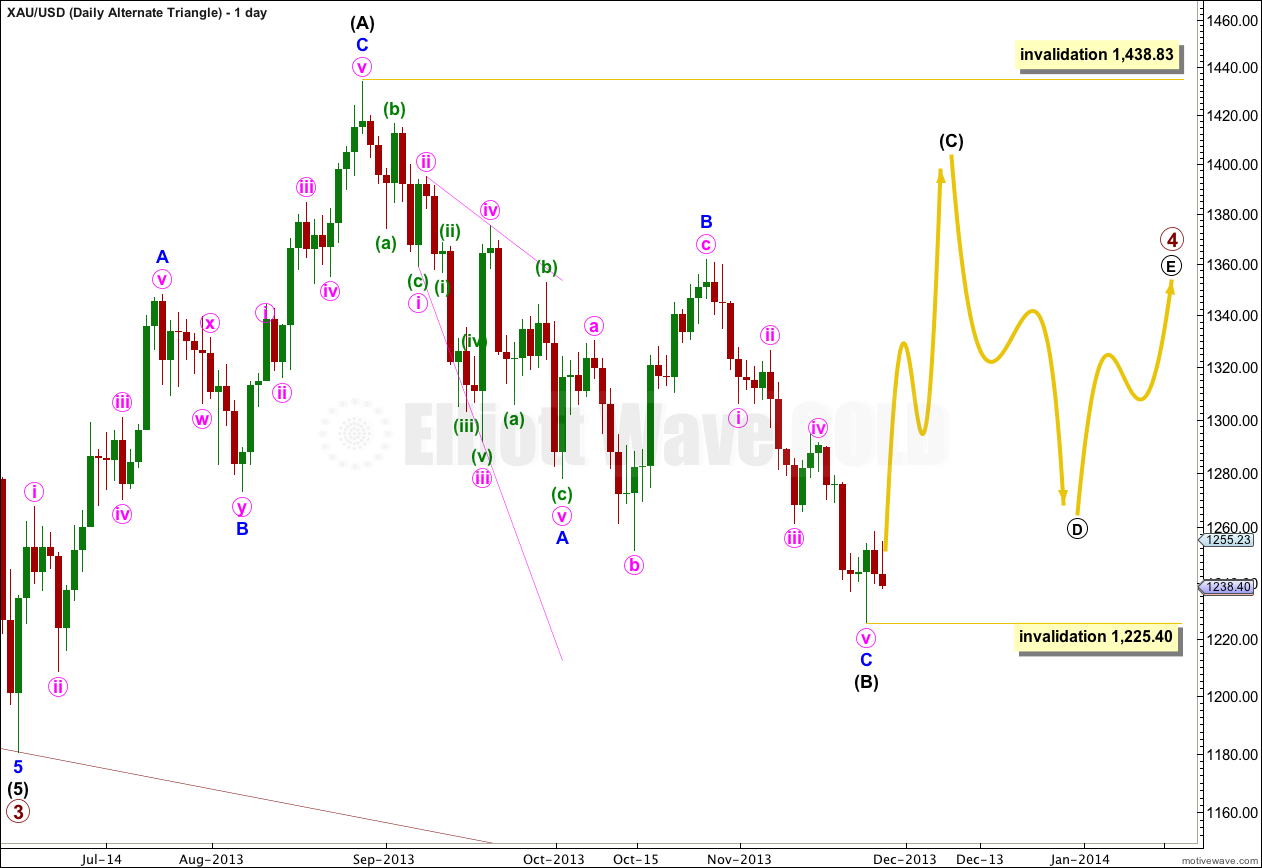Yesterday’s analysis expected upwards movement for a third wave to begin towards a target at 1,286. The target was expected to be one to two days away.
Price did move a little higher, but thereafter moved to a slight new low. The third wave has not yet begun. Price remains well above the invalidation point, and the wave count is only slightly changed.
Click on the charts below to enlarge.
Gold is still within a large fourth wave correction at primary wave degree which is incomplete. It is unlikely that primary wave 4 was over at 1,433.83 as a single zigzag because it would have lasted only nine weeks. Its counterpart primary wave 2 lasted 53 weeks. This is too big a difference for the wave count to have the “right look”.
It is likely to continue as a double combination because within it intermediate wave (X) is reasonably deep. Double zigzags normally have more shallow X waves than this one is.
The purpose of double combinations is to take up time and move price sideways, and I would expect intermediate wave (Y) to end about the same level as intermediate wave (W) at 1,433.83. Double combinations in fourth wave positions are quite common.
I have drawn a parallel channel about the zigzag of intermediate wave (X) using Elliott’s technique for a correction. Draw the first trend line from the start of minor wave A to the end of minor wave B. Place a parallel copy upon the end of minor wave A. Minor wave C may have ended slightly short of touching the lower edge of the channel. When this channel is finally breached by upwards movement then I would consider that final confirmation that intermediate wave (Y) is underway.
I have also drawn a parallel channel about minor wave C downwards using Elliott’s second technique. Draw the first trend line from the highs labeled minute waves ii and iv, place a parallel copy upon the low labeled minute wave iii. An earlier confirmation of a trend change would come with a clear breach of this channel by upwards movement.
Primary wave 4 may not move into primary wave 1 price territory. This wave count is invalidated with movement above 1,532.90.
Sideways and downwards movement over the last 24 hours is a continuation of a second wave correction. Given the size of this structure I am moving the labeling up one degree.
Minuette wave (ii) is now very close to the 0.618 Fibonacci ratio of minuette wave (i). The structure is incomplete, and a final fifth wave down needs to complete. My expectation would be for micro wave 5 to reach about equality with micro wave 1 at 1,236, which is also about the 0.618 Fibonacci ratio.
Minuette wave (ii) is an expanded flat correction, and within it subminuette wave a is itself an expanded flat. Subminuette wave b is a 107% correction of subminuette wave a.
When minuette wave (ii) is completed (which should be within a couple of hours) then minuette wave (iii) upwards should begin. If minuette wave (ii) ends at 1,236 then minuette wave (iii) would reach 1.618 the length of minuette wave (i) at 1,282. If minuette wave (ii) does not end at 1,236 this target must be recalculated, so it may change tomorrow. I would expect minuette wave (iii) to be about 46.29 in length.
Minuette wave (ii) may not move beyond the start of minuette wave (i). This wave count is invalidated with movement below 1,225.40.
Alternate Daily Wave Count.
It is also possible that primary wave 4 may continue as a regular contracting (or barrier) triangle.
The expected direction and structure of this next upwards wave is the same, but for this alternate intermediate wave (C) of the triangle may not move beyond the end of intermediate wave (A). The triangle is invalidated with movement above 1,438.83.
If the triangle is contracting then the following downwards wave for intermediate wave (D) may not move beyond the end of intermediate wave (B) at 1,225.40.
If the triangle is a barrier triangle then intermediate wave (D) may end about the same level as intermediate wave (B) at 1,225.40, as long as the B-D trend line is essentially flat. What this means in practice is that intermediate wave (D) could end slightly lower than 1,225.40. This is the only area where Elliott wave rules are not black and white.
The final intermediate wave (E) upwards may not move above the end of intermediate wave (C) for both a contracting and barrier triangle. E waves most commonly end short of the A-C trend line.
All five subwaves of a triangle must divide into corrective structures. If this next upwards movement subdivides as a zigzag which does not make a new high above 1,438.83 then this alternate would be correct.
Triangles take up time and move price sideways. If primary wave 4 unfolds as a triangle then I would expect it to last months rather than weeks.



